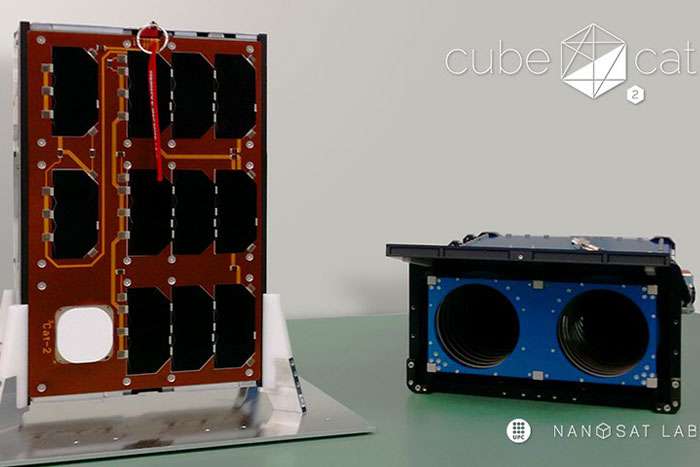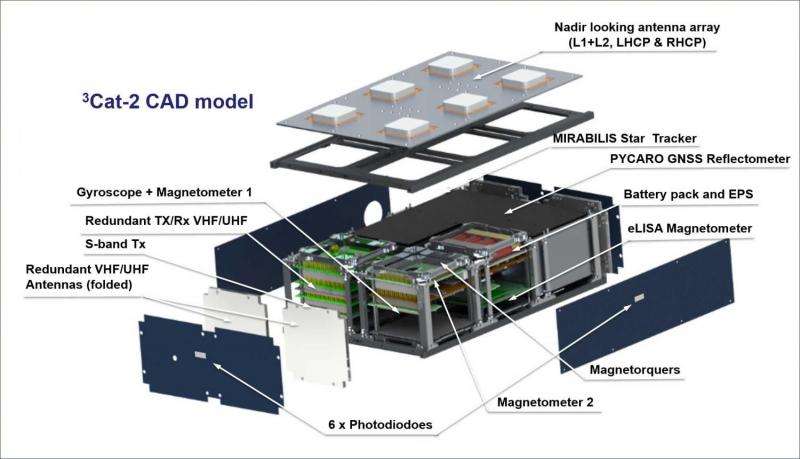The first Catalan nanosatellite successfully launched with three experiments on board

CubeCat-2 is the first Catalan nanosatellite to be placed in orbit. Designed and built by researchers of the Remote Sensing Laboratory of the Department of Signal Theory and Communications and the NanoSat Lab, both at the Universitat Politècnica de Catalunya (UPC), the satellite carries three experiments to demonstrate the feasibility of techniques and technologies related to the use of satellite navigation signals for remote sensing applications. It will also test instruments for a future mission of the European Space Agency.
At 7.40 p.m. CEST on 15 August, an LM-2D rocket was launched from the Jiuquan base in China, putting three mini-satellites into orbit at an altitude of about 500 km. One of them was 3Cat-2, the first Catalan nanosatellite to be put into orbit. The device was built by the Remote Sensing Laboratory of the Department of Signal Theory and Communications and the NanoSat Lab, both at the UPC, and will start to perform scientific tests for the use of navigation signals (GPS, Galileo and others) for observing the Earth. The NanoSat laboratory is an initiative of the Barcelona School of Telecommunications Engineering (ETSETB), with the support of the Institute of Space Studies of Catalonia (IEEC). In addition to science and education, it also offers companies and institutions the opportunity of qualifying the components that they want to send into space.
Nanosatellites, especially those of the CubeSat type, are small systems about 10 centimetres high that weigh between 1 and 10 kg but have the same functionality as a conventional satellite. The researcher Adriano Campos, one of the directors of the NanoSat Lab and head of 3Cat-2, says that these devices make it possible to "try things in space that no one has ever tried before, such as putting into orbit payloads for scientific experiments and for analysing the behaviour of a material or technology". These payloads can therefore be defined as "technology testers" or "small scientific missions". Some of these technologies, such as chips and transmitters/receivers for wireless cell phone communication, are already on the market.
What does 3Cat-2 do in space?

Designed to function as a constellation of satellites, 3Cat-2 is the result of more than five years' work, although it was first conceived in 2003. 3Cat-2 weighs about seven kg and is 34.5 cm long, 24.4 cm wide and 10 cm high. The project received €750,000 in funding to demonstrate the feasibility in space of these new techniques and technologies, which seek to use the signals emitted by global navigation satellites for observing the Earth. The main useful payload is the PYCARO reflectometer, which is designed to compare a direct signal from a global navigation satellite system (GNSS) such as GPS, GLONASS, Galileo and Beidou with the same signal reflected to Earth. PYCARO therefore operates as what is called a bistatic radar, i.e. it does not emit a signal but merely captures the signals emitted by other systems. This technique is known as GNSS-R, and can be used to obtain data on ocean altimetry, sea conditions and soil moisture, among other applications.
The payloads carried by 3Cat-2 include the star tracker Mirabilis, also developed by the Department of Signal Theory and Communications and the NanoSat Lab at the UPC, and an experimental magnetometer developed by the LISA Gravitational Astronomy group of the Institute of Space Sciences (ICE), a joint centre of the IEEC and the Spanish National Research Council (CSIC); the magnetometer is for the future eLISA gravitational wave observatory of the European Space Agency (ESA) on the LISA Pathfinder mission. Through this collaboration, 3Cat-2 will also be a test bench for an instrument designed for a future mission of the ESA. In addition, for the first time in space, 3Cat-2 will use FAPEC, a powerful data compressor developed by the company DAPCOM, a spin-off of the UPC and the University of Barcelona.
The nanosatellite passes over the North Campus twice a day, for 10 minutes. Its aim is to demonstrate new Earth observation techniques that use the signals emitted by navigation satellites. The main difference with previous experiments is that the UPC nanosatellite can provide information on the signals emitted by satellites that is more valuable and more detailed.
Provided by Universitat Politècnica de Catalunya (UPC)




















